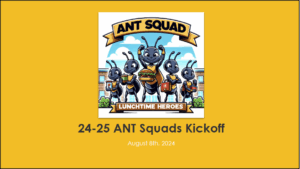Lest you start to think I’m some kind of robot who only produces worksheets to help keep teachers organized, occasionally, I’m going to keep you on your toes by letting you in on my personal life. Because, yes, I do have one! And it is one of the biggest drivers of why I do the Together Teacher work. I want more free time!
Last weekend, I took a day-long cooking class with my pal Phoebe at the Culinary Institute of the Arts in Hyde Park, New York. It was aptly titled Gourmet in Minutes.
Here we are, sporting our chef’s hats and holding raw meat (well, Phoebe was holding it because I’m a little squeamish like that). If we look a little tired, that’s because in addition to our regular jobs we chase two-year olds on the weekends. But, I digress.

Phoebe and Maia sporting their chef’s hats
So, why am I telling you all of this? Well, during the class, I couldn’t resist thinking about how much the process of cooking resembles the art of teaching. As we learned how to make good food fast, I kept thinking of three big ideas:
-
- Preparation matters. And it makes execution a lot easier. We walked into the training kitchen and everything was prepared. Each cooking station was set up with trays of spices, meat was already sliced and lying in wait in the refrigerator, and bowls, knives, and other utensils were neatly laid out. At first, I was shocked at the amount of work that had gone into preparing for us. But then I remembered. . . I didn’t sign up for this class to learn how to measure things or get stuff out of the refrigerator! I was here to combine good ingredients and cook good food, and the team at CIA knew that. They didn’t waste our time on tasks that were not essential to the lesson (though we did have to wash dishes in exchange for extra tiramisu).Lesson Distilled: Too many of us waste our students’ time by assigning them work that is not fundamental to their learning. Yes, it is sometimes helpful to ask them to cut out the sorting activity before starting with the word matching lesson. But unless your aim is “Students will use scissors to cut effectively,” don’t waste a moment of your students’ time having them do busy work that isn’t essential to the heart of the lesson.
-
- Teamwork goes a long way.The cooking class was arranged into teams of three or four. Much like a third grader who doesn’t want to be separated from her best friend, I clung to Phoebe’s arm. We were thankfully put in the same group, and joined by Arthur, a banker. I must admit I was initially skeptical about his ability to contribute but I was thankfully proven wrong. Arthur had an amazing eye for presentation (which does matter when you are attempting gourmet meals), and he gave all kinds of suggestions on how to arrange our final results. Exhibit A is posted below for your viewing pleasure. Arthur saved me lots of minutes by suggesting I segment my oranges in a faster way; then, he showed me how to do it, and then he let me do it.Lesson Distilled: Reach out to colleagues in your building with specific requests to help you save time. They can likely help you with anything from providing resources so you don’t reinvent the wheel, to giving you feedback on a process you could do more efficiently, to observing you in action. There is probably something you can learn from everyone.
- Practice helps. A lot. If you have ever seen an industrial Viking stove, you know what I mean when I say I was scared to go near the thing. Lots of hot burners and high flames as we pan-fried pork tenderloin! But our teacher, Chef Mike, was cool as a cucumber. When he was at the stove, he did awesome chef moves like grabbing the pan with his bare hands, deftly adjusting multiple burners, and patiently responding to twenty people in danger of screwing things up at any minute. When I asked to him after class how he stayed so relaxed under pressure, he told me, “I’ve seen all of these problems before.” Because of his experience, Chef Mike knew when to tell me to add a little extra broth to my deglazing mess and when to tell me to step back and just watch him. He modeled when he needed to, but he also let me mess things up in the name of learning. Note: there are no pictures of the couscous salad.Lesson Distilled: Teaching gets easier. Like Chef Mike, you start to see the same challenges over time, the same struggles students have with decoding or behavior or multi-step math problems. Over time, you can apply more solutions because you have seen more and tried more and learned what worked and what didn’t. It will not always be this hard.
Sometimes it can be so helpful to step out of your teacher-head and go be a learner somewhere. Try it!
Just for fun, here is one of our final products, a fennel and orange salad. Let me know if you want the recipe!

I never would have piled those pretty green olives artfully in a heap if Arthur hadn’t suggested it!


